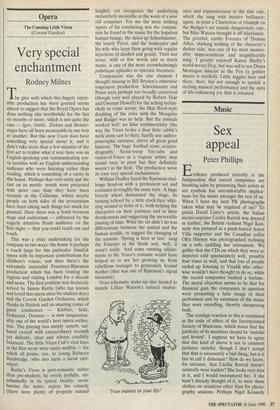M u s ic
Sex appeal
Peter Phillips
Evidence produced recently in the Independent that record companies are boosting sales by presenting their artists as sex symbols has uncomfortable implica- tions for the sexier amongst the rest of us. When I have my next PR photographs taken what may be required of me? To précis David Lister's article: the Italian mezzo-soprano Cecilia Bartoli was dressed in leather, the British violinist Nigel Ken- nedy was pictured as a punk-haired Aston Villa supporter and the Canadian cellist Ofra Harnoy was photcigraphed reclining on a sofa cuddling her instrument. We gather that the CDs on which they were so depicted sold spectacularly well, possibly four times as well, and that lots of people ended up listening to Vivaldi who other- wise wouldn't have thought to do so, while the record companies banked a fortune. The moral objection seems to be that for financial gain the companies in question were presenting a false image of their performers and by extension of the music they were recording, thereby cheapening both.
The condign reaction to this is contained in the code of ethics of the Incorporated Society of Musicians, Which states that the publicity of its members should be 'tasteful and honest'. I suppose we have to agree that this kind of sleeve is not in common parlance tasteful, though I don't accept that that is necessarily a bad thing; but is it fair to call it dishonest? How do we know, for instance, that Cecilia Bartoli doesn't normally wear leather? She looks very nice in it, and I Would recommend her, if she hasn't already thought of it, to wear these clothes on occasions other than for photo- graphy sessions. Perhaps Nigel Kennedy
always supported Aston Villa. Anyway, whether these styles were invented on the spot or not, it looks to me as though the protagonists are enjoying them, so a charge of dishonestly making use of them won't stick.
Dishonesty to the music is a more difficult one. The thinking behind choosing illustrations for record sleeves has many ramifications, but in the end a direct bearing on the music itself is not really a possibility. The requirement to make a slab or black vinyl, or whatever the CD equiva- lent is, attractive is an art with peculiar rules. For my own records I try to find first-rate paintings of the date and country of origin of the main composers repre- sented. I could argue that the painting offered some illumination of the intellec- tual world which produced the music; but in commercial terms this explanation would only be of interest if it encouraged people to buy the record, so I desist. I know that in a specialist market it probably does help a little, though not as much as simply having an attractive picture on display. For, although the picture is cru- cial, its influence is temporary: it must create or confirm an interest in the music, otherwise, except in the very shortest term, it will have failed.
For this reason I believe that record companies cannot afford to be outrageous or ridiculous in their sleeve designs. The relationship between a cover picture and the music behind it is close, if loose, and demands respect. If a company were to put a photograph of a naked performer on the front of classical repertoire, the musician and the music would acquire a reputation which very quickly indeed would become counter-productive. Everyone involved might make money to start with, but subsequent projects with that performer, that composer or that piece would be tainted. Reviews would be catty, general comment destructive. If the big labels get away with this kind of marketing in pop music, it must be because the music and the artists are temporary events. The prob- lem with music from the past is that the amount of it is finite: one messes around with one's reputation for recording Mozart with caution, because once it is blown there is no going back. No amount of mass buying in the first months after a release will, in the long run, save a label which has gained the stigma of dragging our cultural heritage (or whatever the slogan is) into the bog.
So, let these companies continue to explore where the natural limits to this kind of presentation really fall: no one is the worse for it and it makes looking through the record stacks a much more colourful experience than it used to be. Meanwhile I wish I could find a publicist who could do for me what has been done for Cecilia Bartoli. I've never worn leath- er, and I want lots more people to listen to Renaissance sacred music.



















































 Previous page
Previous page